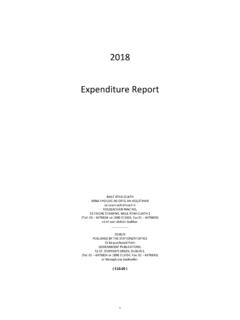Transcription of Government Health Expenditure in India: A Benchmark Study
1 Government Health Expenditure in india : A Benchmark Study Undertaken for the MacArthur Foundation, india by Economic Research Foundation New Delhi August 2006 2I. Introduction It is well known that Health Expenditure in india is dominated by private spending. To a large extent this is a reflection of the inadequate public spending that has been a constant if unfortunate feature of Indian development in the past half century. This is particularly unfortunate because of the large positive externalities associated with Health spending, which make Health spending a clear merit good. The greater reliance on private delivery of Health infrastructure and Health services therefore means that overall these will be socially underprovided by private agents, and also deny adequate access to the poor. This in turn has adverse outcomes not only for the affected population but for society as a whole.
2 It adversely affects current social welfare and labour productivity, and of course harms future growth and development prospects. This is why the perceptions that Government spending on Health has been further undermined during the period of economic liberalisation since the early 1990s create concern, and need to be investigated. This Study seeks to examine the actual pattern of Government spending on Health and related areas (particularly, family welfare and child development) by both central and state governments. In this section, the theoretical arguments for public intervention and need for public expenditures in Health are discussed, and the international experience in this regard is considered. In the following section, the broad patterns of aggregate Health spending in india are analysed, along with the shares of public and private Expenditure and the significance of Health spending in household budgets.
3 The third section contains an analysis of central Government budgets on Health , family welfare and child development over the period 1993-94 to 2003-04. The fourth section takes up the Health budgets of state governments, with special attention to patterns in 15 major states. The fifth section considers some of the implications for Health outcomes not only life expectancy, infant mortality and similar indicators, but also evidence on morbidity. Some of the recently released results of NFHS-3 for 5 states are considered in relation to the evidence on Government Health Expenditure in these states. The final section draws some preliminary conclusions and suggests areas of future 3research and specific question that merit more detailed investigation in the basis of these conclusions. The theoretical case for public Expenditure on Health There is a consensus among social scientists that Health care is different from other goods and services, because of greater likelihood of market failure.
4 The two main characteristics of Health care which lead to market failure and thus necessitate state intervention are the presence of externalities and information asymmetries. An externality results when an action of an agent has an effect not only upon the agent but also upon others. If a good or service not only benefits those who purchase these but others as well, then there is said to be a positive externality in its consumption. Conversely, a particular action of a producer may generate a negative externality, such as pollution. In the case of positive externalities, the operation of market forces alone would lead to sub-optimal consumption and production of the relevant good or service. This necessitates state intervention in order to ensure that sufficient resources are directed to the production of such goods or services, which in turn would result in an increase in the society s welfare.
5 It has been argued that such externalities are less evident for general Health care services such as physician and hospital care, and greater in the area broadly known as public Health . The latter relate to interventions targeted at overall conditions of nutrition and sanitation that determine Health , as well as communicable diseases which are passed either directly among humans or indirectly through the physical environment. An action taken by one person ( ensuring clean, safe water, immunizing oneself against, or seeking treatment for, a communicable disease) generates direct Health benefits for other individuals, through reduced rates of disease. Clearly, purely market-oriented or individually based activities would ignore the wider positive external effects, and therefore yield less than socially optimal levels of such activity.
6 However, even general Health care services that apparently affect only individuals have positive externalities, not only because of the social costs of morbidity, but because inequalities in 4health care create other social concerns. These positive externalities make Government intervention essential. Such intervention can take the form of price subsidies to encourage or spread the consumption of Health care services, or direct public provision of such services. Asymmetric information reflects any situation in which one party to any contract or exchange has access to some information that is not known to the other party. Such information asymmetries, primarily between the service provider and patient, pervade the Health sector and cause market failure in both Health care and Health care insurance markets. For example, in any society, patients know best how improvements in the Health affects their own well-being, while providers have better information regarding both the causes of ill- Health and the effectiveness of alternative Health care services in restoring Health or preventing the further deterioration of Health .
7 There are also problems of incentive incompatibility , in which the interests of the patient and the Health care provider need not coincide. These point to the need for Government intervention in the form of regulation. Such regulation can take the form of licensing of Health care providers, limits on advertising, insistence on some professional norms that prohibit low quality, etc. Such regulation has to ensure balance between the need to increase welfare by improving or ensuring quality, and the welfare reducing effects of inadvertently granting monopoly powers to providers. Therefore from both the efficiency and equity grounds there, is no alternative to the public provision of Health care. Even for the success of an insurance system based on private provision, increased public Health spending and reforming of public Health facilities are necessary.
8 This is what makes the theoretical case for Health Expenditure by the Government . The international experience Health Expenditure is highly unequal across the globe. As is to be expected, the developed countries spend the most on Health per person. OECD countries accounted for less than 20 per cent of the world's population in the year 2000 but were responsible for 5almost 90 per cent of the world's Health spending. Therefore 80 per cent of world s population spent only 10 per cent of the total Expenditure on Health . This includes people in the Asia-Pacific as well as African and Latin American countries. Africa accounts for about 25 per cent of the global burden of disease but only about 2 per cent of global Health spending. (World Health Report, 2003). Similarly, Health Expenditure , both in terms of percentage of GDP spent on Health and per capita Health Expenditure , is much higher in the developed countries, as evident from Table 1.
9 The share of GDP spent on Health ranges from a low of per cent in Azerbaijan to per cent in the USA. Similarly there is a very wide variation of per capita Health Expenditure across countries, which is typically extremely low in developing countries compared with most of the developed countries. The range in 2001 was from $14 in Ethiopia to $4877 in the USA. What is also notable from Table 1 is the much higher ratio of public Health spending to private spending in the developed countries. By contrast, in middle developed and low developed countries, either private Expenditure dominates or there is very little difference between the shares of private and public Expenditure , although in general both tend to be low. It is notable that india has the lowest ratio of public to private Health Expenditure among all the countries described in this table, including the poorest countries.
10 Further, all the private Expenditure in india (as in some other countries) is constituted by out-of-pocket expenses. This is inherently regressive and puts a disproportionate burden for Health care on poor households. 6 Table 1: Health Expenditure and Health Indicators in selected countries. Health Exp. as % of GDP (2001) HDI Rank Country Public Private Per Capita Exp on Health (PPP US $) Out-of-pocket Exp as % of Private Exp (2001) Life Expectancy at Births (2001) Infant Mortality Rate Per 1000 live Births (2001)) Per Capita GDP ($) (2001) 1 Norway 2,920 4 36974 2 Iceland 2,643 3 27032 3 Sweden 2,270 100 3 23680 4 Australia 3 2,532 79 6 19054 7 U S A 4887 7 34946 8 Canada 2,792 5 22385 9 Japan 2.






